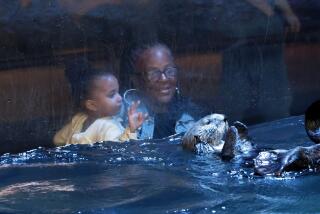Killer Whale at Sea World Apparently Died of Old Age
Preliminary results of a necropsy announced Tuesday at Sea World indicate that old age killed Orky the killer whale.
“The gross findings of the necropsy supported our original diagnosis of an advanced geriatric condition,” said a statement issued by Jim Antrim, general curator at the park. “Final confirmation of this diagnosis will have to await the results of microbiology and histopathology tests, which will take six to eight weeks to complete.”
Dan LeBlanc, chief spokesman for the park, said the autopsy revealed obvious signs of Orky’s age. The oldest killer whale in captivity anywhere, he was estimated to be 27 to 32 years old. Biologists say male killer whales live at least 30 years in the wild, although some contend that the average life span is at least one to two decades longer.
“As we looked at his organs, it was obvious. You could see that many of the organs had degenerated,” LeBlanc said.
Orky sank to the bottom of his pool and died early Monday, just three days after the calf that he fathered was born to one of the the three adult females at Sea World here. A second calf he sired is expected to be born soon at the San Antonio Sea World.
The autopsy yielded a legacy that will live on in cell cultures, DNA analyses and studies of Orky’s anatomy by scientists.
Accustomed to controversy over the idea of keeping the huge mammals in captivity, Sea World executives were reacting cautiously Tuesday to questions about what would happen to Orky’s body.
But LeBlanc acknowledged that samples of tissue from Orky are being given to whale researchers across the country to help answer questions about killer whales that cannot be addressed in any other way.
“There’s a whole number of things that they’ve already learned by having him in captivity for such a long time,” said Jim Lecky, protected species branch chief for the National Marine Fisheries Service’s regional office in San Pedro. “From his death, they can go in and investigate in more detail maybe some of the processes that contributed to his death and learn how to prolong life.”
“To me, one of those animals that dies becomes such a valuable specimen for its whole species,” said Deborah Duffield, a Portland State University biology professor who specializes in anatomical and genetic analyses of marine mammals. Duffield also runs a network that rescues marine mammals along the Oregon coast.
“In an animal like Orky, you can look for what goes on in an animal whose health you’ve followed for all those years. You can ask what goes on in lungs, and other organs, with age,” she said. “This kind of information when we handle a stranded animal is very valuable.”
At the University of California’s Santa Cruz campus, marine biologists might be interested in studying the sound-producing structures in Orky’s head “to see if our ideas about sound production and its conduction out of the head would apply to killer whales, like it has to the dolphins we have been working on,” said Ken Marten, coordinator of the bioacoustics laboratory there.
Use for Skeleton
Even Orky’s skeleton--cleaned of flesh by burial and reconstructed in the same way dinosaur bones are--could not only provide an awe-inspiring exhibit for visitors but also show how bone structure affects behavior.
“I’m so excited about the bones because they are so beautiful,” said Duffield, who has reconstructed skeletons for Sea World in the past. “Bones have done so much toward making people understand what these animals really are.
“For example, on the killer whales, we hadn’t learned about what makes them able to bend their tails so much more than other marine mammals,” Duffield said. Other whales and dolphins don’t have this ability, and looking at a killer whale’s skeleton quickly reveals that the reason is the way the vertebrae in the tail are linked, she said.
“They have a very unique way that the bones in the tails are constructed. It’s the reason they can hoist sea lions up on their tails when they’re feeding on them,” she said.
On a more microscopic level, Duffield and others can be expected to use tissue samples from Orky’s corneas to grow cell cultures that can be preserved indefinitely for later genetic and other analyses. Tissues of heart, liver and other organs can be used to extract the hereditary chemical DNA as well as other proteins for study.
Captured in 1968
Researchers know, for instance, which pod of killer whales near British Columbia Orky was captured from as a juvenile in 1968. Consequently, comparing Orky’s genetic makeup and that of other whales captured or found dead in the area could help answer questions about relationships among the whales of the Puget Sound area.
Observations of killer whales there have shown that they generally live in tight matriarchal family groups with a definite home range, but that some whales don’t follow this pattern. This has led to speculation that there may be two subspecies of killer whales off the Northwest coast. However, darting wild whales to collect tissue samples for genetic analysis is proving controversial, so genetic studies of whales like Orky assume more importance.
“They’re taking all kinds of specimens from this animal that we’ll use for years,” Duffield said.
However, a researcher who specializes in observing killer whales in the wild noted that most of this kind of microscopic work on Orky won’t be augmented by his death, since genetic studies can be done using blood samples that are routinely taken from animals at Sea World.
The benefit from Orky comes more from his contribution over the past 20 years to changing people’s attitudes about killer whales, said Peter Olesiuk, part of a noted team of whale researchers at the Canadian government’s Pacific Biological Station at Nanaimo on Vancouver Island.
‘Changed People’s Attitudes’
“That’s really what’s changed people’s attitudes toward killer whales--having them in captivity and realizing they are not dangerous animals,” Olesiuk said. “You only have to go back 20 years in British Columbia to have people afraid to go out in boats because of the whales. The Department of Fisheries had a machine gun on an island to shoot killer whales when they came by. Basically killer whales were treated as vermin back in those days. And, of course, nowadays you can’t even think about going out to catch one and put it in captivity.”
Given that opposition to capturing whales, Orky’s status as a proven breeding male made him valuable to the future of Sea World’s popular killer whale shows in California, Texas, Florida and Ohio. Only one breeding male remains, and a second young male has yet to prove a successful breeder.
But the vagaries of chance and of killer whale society seem to be on Sea World’s side in pursuing the breeding program that could assure the parks’ future supply of Shamus to amaze audiences.
The young male, who is about 12 years old, in the next five years will be reaching the stage at which he will likely become an effective breeder--at the same time the older male, which is 20 to 25 years old, can be expected to begin declining. Research on whale societies in the wild and the experience in captivity have shown that a single male can easily be used to breed with multiple females, even if they are scattered across the country, biologists say.
Transporting whales by plane, though controversial among whale advocacy groups, appears not to harm the animals, Duffield said.
If inbreeding were to become a problem, whales in Canadian aquariums might be available for breeding, she noted.
Meanwhile, the birth of “Baby Shamu” last Friday can be expected to be a boon for Sea World despite Orky’s death, according to Bert Boksen, an industry analyst with Raymond, James & Associates, a St. Petersburg, Fla., brokerage. Sea World “won enormous publicity around the country with the birth of that whale,” Boksen said. “Every station in the U. S. ran tremendous footage of that on the news. You can’t buy that kind of publicity. It’s priceless.”
Sea World officials said they have yet to see any increase in attendance because of the baby, but they said visitors are responding positively to the birth.
More to Read
Sign up for Essential California
The most important California stories and recommendations in your inbox every morning.
You may occasionally receive promotional content from the Los Angeles Times.










